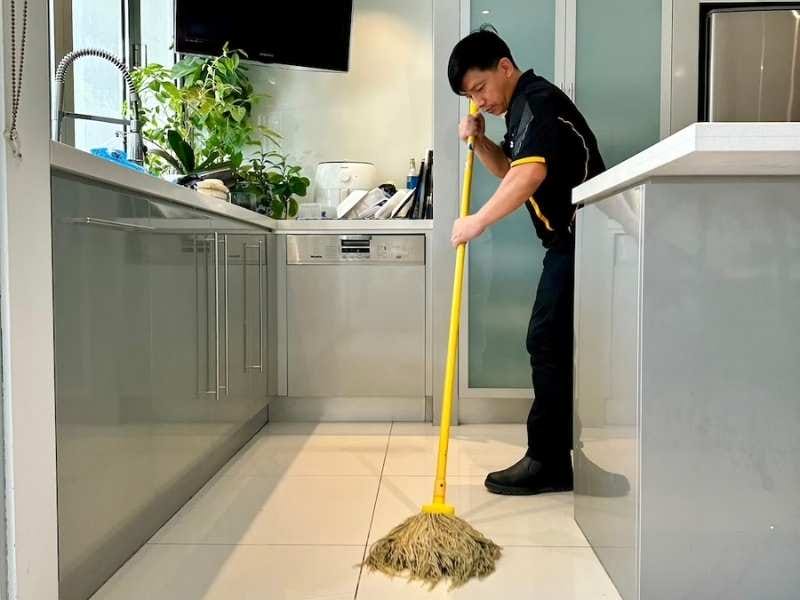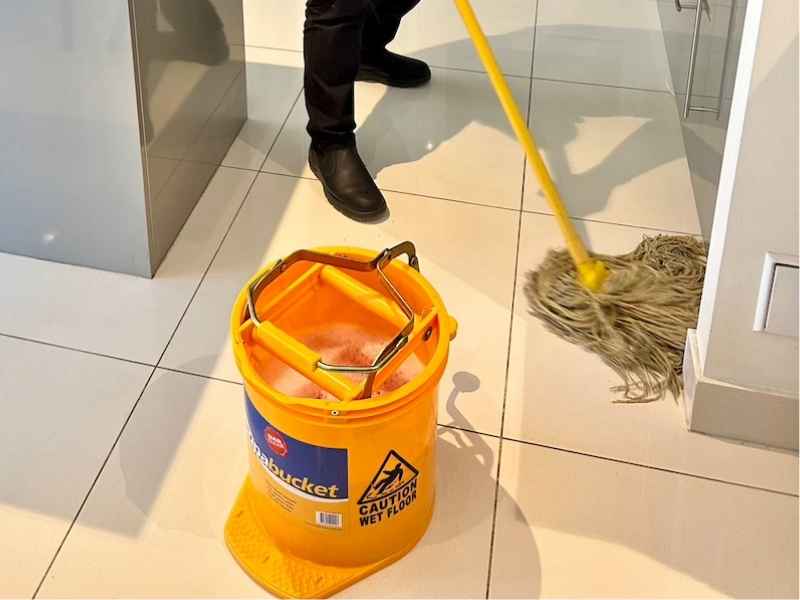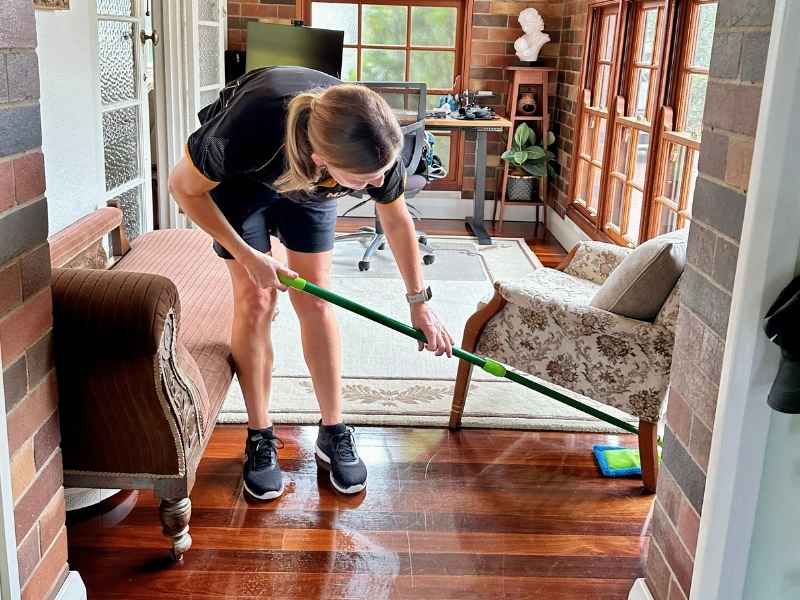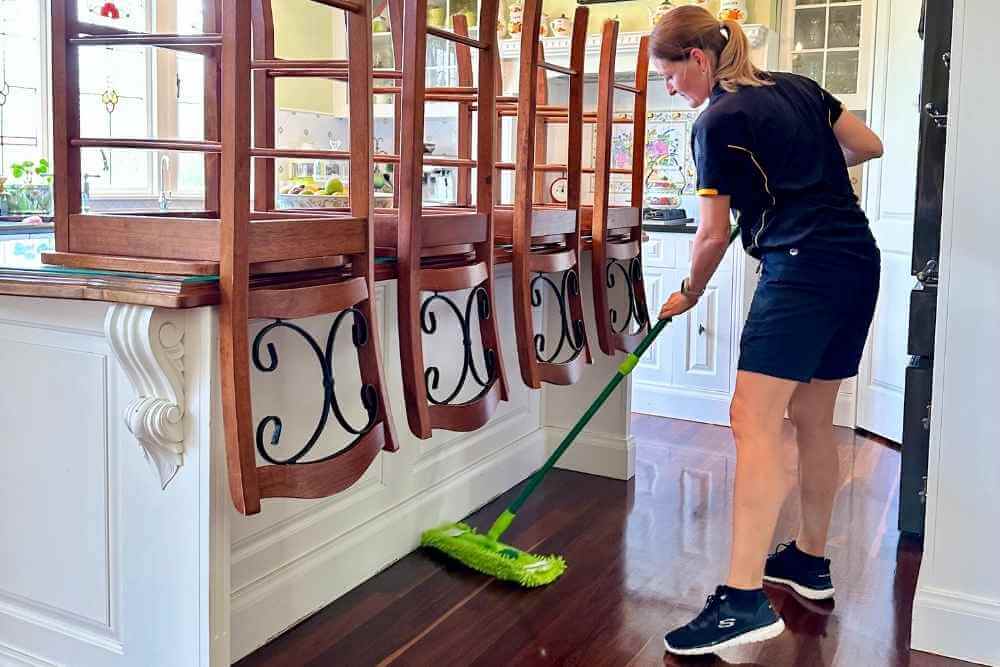The only thing worse than a still-dirty floor despite mopping? A weirdly sticky floor, which feels so unpleasant under your feet.
It’s pretty frustrating to put in all that effort and end up with sticky floors after mopping. There are a few reasons for this, such as:
- Wrong amount of floor cleaner
- Inadequate rinsing
- Wrong cleaning solution
- Dirty water when mopping
- Not drying properly
- Poorly cleaned mess
- Dirty mop head
Don’t let your floors turn into a dirt magnet after you’ve worked so hard to clean them! We’ve asked our professional cleaners for the most common reasons your floor’s sticky after mopping — and how to fix it.
Why Your Floor Feels Sticky After Mopping

If you’ve got sticky floors, it’s usually due to a mistake in your cleaning routine — say, the cleaning product or the water you used.
Thankfully, they’re all simple issues with easy solutions!
Wrong amount of floor cleaner
This is one of the most common reasons for sticky floors after mopping — whether laminate, tile, or wood.
Using too much floor cleaner, even mixed with water, will leave residue after rinsing and drying. Remember, more product doesn’t mean more cleaning!
On the other hand, using too little product means it won’t work properly. That leaves you with a floor that’s still sticky and dirty despite mopping.
HOW TO FIX IT: Use the correct amount of floor cleaner or the correct ratio of product to water. Follow the product recommendations so you’re not over- or under-diluting.
You can also go over the floors with some warm water and a clean mop to remove any leftover product.
Improper or inadequate rinsing
Many floor cleaners need a warm water rinse so they don’t leave residue on the material. If you miss some spots while rinsing — or don’t use enough water — you’ll get a residue on your floor after mopping.
Laminate floors are particularly prone to residue build-up from cleaning products if not fully washed off.
HOW TO FIX IT: If the product requires rinsing, go over your floors with a clean mop and fresh water.
You can dry mop afterwards to remove lingering moisture or cleaner.
Wrong cleaning solution
You need to use a floor cleaner that’s compatible with your floor type when mopping! Different materials require different products — for example, you can’t use a tile cleaner on your hardwood floors.
Using the wrong floor cleaning solution can not only leave your floors sticky, but could also damage the material.
HOW TO FIX IT: Use the correct floor cleaner for the material.
To clean hardwood floors, use a dedicated wood floor cleaner or Castile soap. For laminate floors or vinyl floors, use a mild dish soap or diluted vinegar.
You can clean ceramic tile floors with white vinegar and water, while stone tiles need a good stone cleaner!
Dirty water when mopping
It’s important to use clean water when wet mopping — if you don’t change the water in your mop bucket, you’ll just return that dirt to the floor.
Don’t forget to use fresh water when rinsing, too.
HOW TO FIX IT: If you must use the same bucket, change the mop water once it starts getting murky.
Otherwise, go for the two-bucket method: one for your cleaning solution and the other for rinsing the mop head. This prevents you from transferring dirt back to the floors.
Also, make sure you sweep or vacuum before mopping so you aren’t pushing dirt around!
Not drying properly
Your floors need time to dry after mopping — otherwise, you could get slippery or sticky patches.
Keep in mind that certain types of mops (such as string mops) leave more moisture after use. On the other hand, microfibre mops absorb more water.
HOW TO FIX IT: When you’re done washing the floors, follow with a dry mop to remove excess moisture.
You can also open any windows and point an electric fan at the floor to speed up the drying process.
Poorly cleaned mess
This may be the culprit if you find your kitchen floor sticky after mopping. If someone made a mess — like spilled juice or sauce — and didn’t clean up properly, it could leave a residue that’s difficult to clean!
In particular, foods or drinks with sugar can cause lingering stickiness.
HOW TO FIX IT: Tackle messes on the floor ASAP, and use the appropriate cleaning solution. Don’t forget to dry the floor afterwards!
Dirty mop head
Yes, you’re supposed to clean your mop head or pad! Even steam mop pads can and should be washed after use.
A dirty mop head will track grime all over your floor. The added moisture means you get a sticky, lingering residue.
HOW TO FIX IT: Wash your mop head in hot water and a mild detergent, then let it air dry.
You can also check if the manufacturer allows machine washing — that’ll make it even easier. Most steam mop pads are machine washable.
How to Get Rid of Sticky Floors After Mopping

If you’ve noticed an unpleasant, tacky feeling underfoot after mopping, don’t worry — there are simple solutions to get nice, clean floors again.
Spot clean sticky floors
If there are just one or two sticky patches on the floor after mopping, opt for spot cleaning!
Mix 1 part white vinegar with 4 parts water, then dip a microfibre cloth or soft sponge into the solution. Wring it out, then scrub the sticky spots on the floor.
Rinse the area with a damp sponge, then dry with a clean microfibre cloth.
Mop with soapy water

Often, wet mopping sticky floors will do the trick. This method works well for hardwood floors — just remember to wring out the mop so it’s damp, not dripping.
Fill one bucket with water plus a few drops of anti-grease dish soap, and another with clean water. Mop the sticky floor with soapy water, pausing regularly to rinse the mop head.
(Don’t forget to change the water when it starts getting dirty!)
Quickly dry mop afterwards to remove any remaining moisture and prevent streaks.
Clean with a white vinegar solution
For sticky floors made of laminate, tile, or vinyl, use a cleaning solution of white vinegar and water.
Avoid using this on wood floors, as the acid in vinegar can damage the finish or discolour unfinished timber.
Mix a cup of white vinegar (250ml) per 4 litres of warm water in a bucket. Use that to mop the sticky floor, making sure to regularly wash off the mop in a separate bucket of water.
Rinse the floor afterwards, then dry mop to remove moisture and prevent streaks.
NOTE: Vinegar shouldn’t make your floor sticky, but it can leave a slight residue if you use too much or don’t wash it off properly.
Don’t Get Stuck With Sticky Floors

To prevent sticky floors after mopping, make sure you mop your floors properly! Use the appropriate cleaning solution and thoroughly rinse the floor if needed.
Avoid using harsh chemicals that could leave a residue or damage the floor material. When steam mopping, only use water unless specified by the manufacturer.
Choose a good-quality mop for your floors! Traditional mops are affordable but leave more moisture behind, while microfibre mops are more absorbent and even.
Vacuum and wash the floors once a week to minimise dust and dirt build-up. Or book a regular cleaning service to tackle all the floors — sticky or not — in your home.

